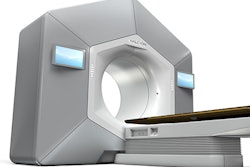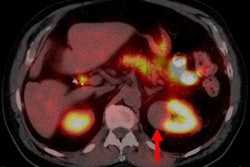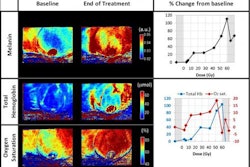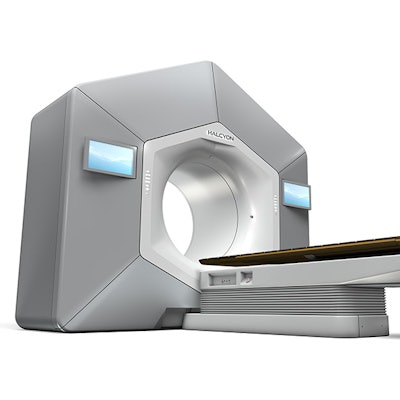
Taking inspiration from diagnostic radiology, radiation oncology firm Varian Medical Systems is launching its new Halcyon platform for radiation therapy at the European Society for Radiotherapy and Oncology (ESTRO) meeting in Vienna. The new system sports a gantry-based design that pays homage more to CT or MRI instrumentation than traditional linear accelerators.
Halcyon is an entirely new platform designed to meet surging demand for radiation therapy treatment in the years to come by making it easier and more efficient to deliver treatment, according Mu Young Lee, director of new product solutions at the Palo Alto, CA, company. Some forecasts have predicted there will be nearly 25 million new cancer cases diagnosed annually worldwide by 2030, which would require up to 20,000 new linear accelerators (linacs) globally to meet the world's growing cancer burden.
While vendors can build more radiation therapy machines, education and training issues would make it difficult for healthcare providers to maintain the staffing levels required to keep them running.
"We can build more linacs," Young said. "But we can't graduate more radiation oncologists from medical school."
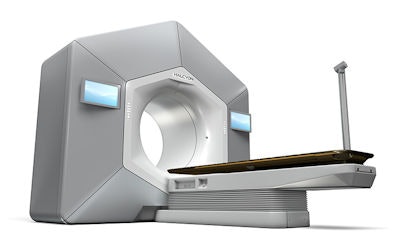 Halcyon is a new radiation therapy platform that derives inspiration from diagnostic radiology. Image courtesy of Varian.
Halcyon is a new radiation therapy platform that derives inspiration from diagnostic radiology. Image courtesy of Varian.Halcyon is designed to address the problem with a radiation therapy system that's easier for providers to operate while being more comfortable for patients, Young said. To develop the system, Varian decided to fundamentally rethink the basic design that's dominated medical linear accelerators for decades: a large C-arm that moves in an arc around the patient while delivering radiation therapy.
Instead, Varian's engineers took inspiration from diagnostic radiology, where all of an imaging modality's moving parts are hidden behind gantry covers. Not only are Halcyon's moving parts hidden, but patients receiving treatment for the first time are presented with a machine architecture that they are probably already familiar with -- the scanner with the donut-hole gantry.
"Patients have already had imaging with various modalities before they show up for radiation therapy," Young said. "With Halcyon, there isn't this big machine swinging around."
But Halcyon's changes go beyond its appearance. Varian has built image guidance into the system, so that 100% of all Halcyon treatments are performed with imaging thanks to a conebeam CT capability housed under the covers. This helps reduce uncertainty in treatment, Young said.
Halcyon is also capable of performing faster treatment than conventional linac designs. The system performs a full rotation around the patient in 15 seconds, compared with 60 seconds for a conventional C-arm design, and the unit's new dual-layer multileaf collimator (MLC) is both faster and provides better dose modulation, adjusting the radiation beam to better conform to the tumor.
In designing Halcyon, Varian also took a look at streamlining the treatment planning process. Older intensity-modulated radiation therapy (IMRT) plans could have up to 30 steps; Varian reduced this to nine. The company has been testing Halcyon with its Eclipse treatment planning software, and the combination is receiving high marks for quality treatment plans when assessed against web-based metrics.
Varian has also aimed to provide a low total cost of ownership for Halcyon. The system offers one-third to half the electrical use of a conventional linac, and it has shielding built into the gantry, which means it requires less room shielding and can be sited in vaults as small as 5.9 x 5.5 m. It can be installed in two weeks or less.
With respect to patient comfort, Varian implemented a variety of design improvements to make the system more patient-friendly. The gantry is 100-cm wide -- even wider than the 85-cm apertures found on the widest treatment-planning CT scanners -- and features noise reduction technologies such as a linear motor that uses magnetic coils pushing on rows of permanent magnets for quiet, smooth operation.
In a novel touch, the system sports a camera mounted on a stick at the foot of the patient couch. While other radiation therapy systems also have patient cameras, they are usually mounted on a nearby wall. Varian believes that by integrating the camera into Halcyon's couch, linac operators will always have a better view of the patient.
Halcyon will accompany TrueBeam in Varian's family of linac product offerings for radiation therapy. Varian expects that Halcyon will be used as a high-throughput machine with a focus on efficiently performing treatments that can be standardized, while TrueBeam might be used for more complex treatment sessions that require more intensive levels of staff planning and involvement.
Varian has received the CE Mark for the system, and 510(k) clearance from the U.S. Food and Drug Administration (FDA) is expected by midsummer. Production shipments are expected to begin in late summer.




